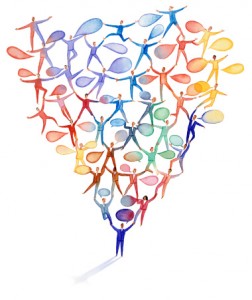The Power of Networks (Part 1)
By Asher Crispe: January 28, 2013: Category Inspirations, Networks of Meaning
 The age of networks has arrived. With billions connected via cellphones and the internet and more joining everyday, our emerging global society is generating an amazing sense of interrelatedness. We may soon get to the point where, in the words of Jorge Luis Borges, “everything touches everything.” Elevating our perception of networks from the social to the cosmic, we can even come to discover how all of Creation is in the process of clarifying itself as one giant nexus.
The age of networks has arrived. With billions connected via cellphones and the internet and more joining everyday, our emerging global society is generating an amazing sense of interrelatedness. We may soon get to the point where, in the words of Jorge Luis Borges, “everything touches everything.” Elevating our perception of networks from the social to the cosmic, we can even come to discover how all of Creation is in the process of clarifying itself as one giant nexus.
For evidence of this in Kabbalah, we need not look further than the first word of the Torah–(Genesis 1:1): Bereshit (“In the beginning”)–which stands as the inception and encapsulation of all the creative process that follows after it. Semiotically speaking, this one word designates a pre-expanded form of the Torah narrative where all of the history to come is compressed into a singular term. All of the Torah is signified therein. To this end, there is an entire work of Kabbalah known as Tikunei Zohar which examines a multitude of permutations that are encoded into this one word. Given its six Hebrew letters, it has 720 possible arrangements of those letters in addition to a wide range of gematria (numerical equivalencies). One such hidden meaning that jumps out at us if we look closely (Bereshit is spelled Beit-Reish-Alef-Shin-Yud-Tav [בראשית]) is the word reshit [רשת](Reish-Shin-Tav) which means a ‘network.’ The remaining three letters (Beit-Alef-Yud) equal 13 (2+1+10 respectively) which is the numerical value of the word echad or “one.” Consequently, we can derive from this that the whole of Creation, the spiritual (heavens) and the material (earth) was, from the the beginning, intended as ‘one network’ [reshit echad].
When we bring everything back to its source, at this ‘point of origin’ it becomes clear that everything is interconnected. What will prove difficult (and which is the challenge of history), is to restore this awareness of our profound connection to all that exists. While contemporary authors such as Fritjof Capra have popularized the idea of a ‘web of life’ as a revolution in human consciousness which for so long had clung to the notion of the separateness of things (and more particularly egos), there is a precedent for this expression in the Ethics of the Fathers (Perkei Avot 3:16) which states “…a net [metzudah] is spread out over all of life….” Additionally, we might even suggest that ‘being alive’ necessitates ‘being connected’ while the opposite of life seems to imply a disconnection.
One of the most basic images of network systems is that of the tree. The Hebrew calendar contains a special day known as Tu B’Shevat (the 15th of the month of Shevat) which is referred to in the Talmud as the New Year for Trees (Rosh Hashannah La’ilanot). If we deconstruct this name, we find that ‘Rosh’ actually means a ‘head’ or more broadly a ‘mindset’ or ‘state of consciousness’ while ‘Shannah’ (year) comes from the same root as the word shinui which means ‘change.’ Thus, every ‘new year’ is actually an opportunity to transform our consciousness. In this case, the ‘mind altering’ applies to our sense of trees. Since the whole topic is bound up with time (year), we need to rethink the temporal unfolding of our consciousness of networks.
While networks can take many forms, the most basic (experientially) would be that of a tree. The tree is even the meta-symbol for the Torah itself. Often referred to as the ‘Tree of Life,’ this characterization of the Torah parallels the ‘Web of Life’ idea almost exactly. Since Life/Creation comes out of the Torah according to the mystics, it would follow that all of the world has network properties. Moreover, the network of the Creation mirrors the textual interrelatedness of the Torah. Extending this even further, we may submit that the entirety of Reality is also one big complex ‘tree’-like system. The kabbalistic hint to this lies in the dating of our ‘Arbor’ day: the 15th day of the 11th month of the Hebrew year. 15 relates to the letter Yud (10) and Hei (5) while 11 can been configured as the sum of Vav (6) and Hei (5). In other words, the day and month designations carry an allusion to the name Havayah (Yud-Hei-Vav-Hei). From this we may surmise that all of ‘Reality’ or ‘Being’ (Havayah) is comparable to a tree. Here we are dealing with an ontological tree.
On another note, it is significant that in Hebrew the word etz (tree) can be viewed as a sub-root of the word etzem (which can also mean ‘Being’ or ‘Essence’) thereby providing a etymological connection to the idea of information ontologies where ‘ontology’ is more like a taxonomic system. We might propose that the combined significance of ‘tree-ontologies’ could be formulated as follows: ‘Being’ means ‘being-in-relation’ or ‘related-being.’ Reality would always already be inter-related reality.
According to the Arizal’s commentary on Sefer Yetzirah, the Hebrew month of Shevat (whose epicenter is the New Year for trees) was created from the letter Tzadi (sometimes called Tzadik) whereas the preceding month of Tevet was created with the letter Ayin. Together Ayin and Tzadi spell the word etz which, once again, is a ‘tree.’ Analyzing these two letters we can derive more insight into how we are to relate to this tree concept. The name of the letter Ayin [ע] means ‘eye’ [עין] while the letter Tzadi is best understood as Tzadik which means ‘the righteous one.’ From this we may understand that the nature of the ‘Tzadik’ or righteous is to be connected and view everything as integral to the tree. Likewise, the Tzadik of a generation would be a leader who could be compared to the trunk of the tree with all other souls being branches. Everyone is connected to this individual and this individual is connected to everyone.
Another angle comes from Devarim/Deuteronomy (20:19) where the Torah designates “man [as] a tree of the field.” The human condition is most treelike both internally (our psychological and biological nature certainly requires interconnectedness) and externally (in our social-spiritual and environmental relations). Thus, on a relative scale, each of us contains an aspect of the Tzadik (righteous one) inside ourselves which reflects our individual capacity to relate to everyone and everything all around us.
Besides the tree (etz) being a image for envisioning universal relatability, we can also go one step further and interpret the Tzadik as a number. Normally, the letter Tzadik equals 90 which (amongst other things) is the equivalent of the word melech or ‘king.’ As often cited in Chassidic teaching, ‘there is no king without a people’ which highlights the underlying relationship that gives meaning to the properties of the person (the king). The figure of self-mastery and determination of reality–the king–carries with him the super-connectivity of the Tzadik (a Tzadik may simply be someone who connects properly with others). It is this interdependent relatedness that focuses our ‘vision’ (Ayin).
 However, there is another way of deciphering this letter. Since the letter Tzadik [צ] falls at the end of the word etz, it is actually a special form of the letter called a Tzadik sofit [ץ]. In the Hebrew numbering system, the 22 letters normally range in value from Aleph (1) to Tav (400). The question arises as to how one continues to count beyond this. The question is compounded when we introduce the five letters [Kaf-Mem-Nun-Pei-Tzadik) that have alternative forms when they appear at the end of a word. They are the ‘final’ letters. In a different 27 letter numbering system, the order continues with a final Kaf being 500, a final Mem–600, a final Nun 700, a final Pei [pronounced Fei] 800 and lastly, a final Tzadik–900. After that we cycle back to Alef because the same name also can be read as elef meaning a 1000. This competes the set. We go from 1 to a 1000 which is also in a way returning back to the beginning again. Following this way of counting, our final Tzadik (as 900) equals the word reshet or a ‘network.’ Subsequently, our word for tree contains within it the imperative to visualize (Ayin) networks (Tzadik = 900 = reshet) as an end state or ultimate model for leadership (king).
However, there is another way of deciphering this letter. Since the letter Tzadik [צ] falls at the end of the word etz, it is actually a special form of the letter called a Tzadik sofit [ץ]. In the Hebrew numbering system, the 22 letters normally range in value from Aleph (1) to Tav (400). The question arises as to how one continues to count beyond this. The question is compounded when we introduce the five letters [Kaf-Mem-Nun-Pei-Tzadik) that have alternative forms when they appear at the end of a word. They are the ‘final’ letters. In a different 27 letter numbering system, the order continues with a final Kaf being 500, a final Mem–600, a final Nun 700, a final Pei [pronounced Fei] 800 and lastly, a final Tzadik–900. After that we cycle back to Alef because the same name also can be read as elef meaning a 1000. This competes the set. We go from 1 to a 1000 which is also in a way returning back to the beginning again. Following this way of counting, our final Tzadik (as 900) equals the word reshet or a ‘network.’ Subsequently, our word for tree contains within it the imperative to visualize (Ayin) networks (Tzadik = 900 = reshet) as an end state or ultimate model for leadership (king).
In Part Two, we will consider the redemptive properties of networks.
http://www.interinclusion.org/inspirations/the-power-of-networks-part-2/
The Power of Networks (Part 1),















;)
;)
;)
;)
;)
;)
;)
;)
;)
;)

Great article thanks Asher!
Thanks!!